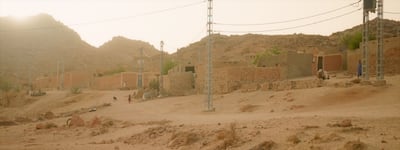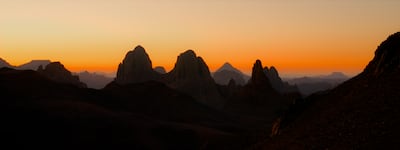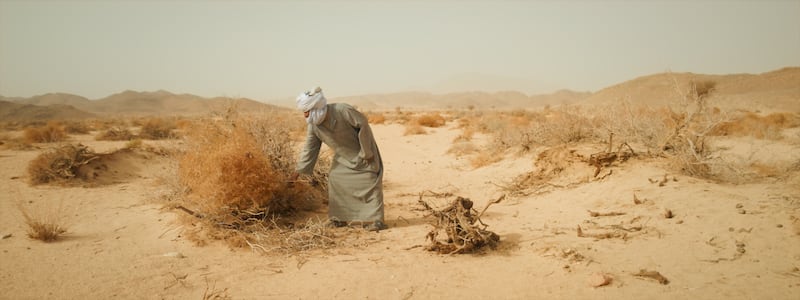Between 1960 and 1966, the French government detonated 13 atom bombs in the Algerian Sahara. The tests signalled France’s accession to the nuclear club and were hailed in Paris as a victory.
“Hoorah for France,” wrote President Charles de Gaulle the morning after the first blast, in a message to his army minister.
Little is known about the bomb's effect in Algeria itself. According to a witness, 60 people died in 1962 after an explosion went wrong.
Inhabitants of the nearby village of Mertoutek say they were evacuated for 24 hours and then told it was safe to return. More than 60 years later, they still say the land and water beneath it is contaminated. When they perform ablutions before prayers, for example, the water hurts their skin.
The international incident, which has been gaining exposure over the past few years, is the subject of a new short film And still, it remains by British filmmakers Arwa Aburawa and Turab Shah.
The husband and wife team had been thinking about how to represent the end of the world and the nuclear tests presented them with the example of a community who had – when they heard the detonations – believed the world was ending.
But when they began investigating the event, they realised there was only documentation of the French side of the story.

“[There was] nothing about the villagers themselves and absolutely nothing in terms of what happened next,” says Aburawa, who grew up in Manchester, UK, in a Palestinian family. “We were interested in the lack of perspective of people on the ground. How did they experience this moment, and then how did they experience life after that?”
Commissioned by the Liverpool Arab Arts Festival to look into how the climate crisis is affecting the Arab world, Aburawa and Shah spent two years researching the tests. In 2022, they travelled to the small village of Mertoutek.
Located in the foothills of the Hoggar Mountains, Mertoutek is profoundly isolated. Most of the villagers have never been to the nearest town, which is four hours away – itself a two-hour plane ride from Algiers. Most trace their ancestry to tribes from Mali and Niger who migrated to the village 400 years ago.
Aburawa and Shah were prepared to be ignored, but they were instead immediately welcomed. The villagers were keen to tell their side of history, the pair say, and were as interested in Aburawa and Shah as the filmmakers were in them and their stories.
Aburawa, who could communicate in Arabic with some of the elders of the village, was invited into gatherings with the women, who wanted to know how she celebrated her traditions as a Palestinian. Every morning, the young girls of the village would come by their house to see if she wanted to come herd the goats, she says, or to teach her their games.
The villagers ended up changing the shape of the film. Aburawa and Shah had initially been taken by the very poetic metaphor that followed the detonations – that the dust cloud of radioactive material travelled along the northern winds towards France, in effect returning to pollute the country that had perpetrated the tests.
“But when we visited Mertoutek, we learnt they have a long, long history. They told us how their families had been in the village for hundreds of years, and people before that for thousands of years,” says Aburawa.
“Suddenly, our concept of time and how to place a community’s experience in the moment massively shifted. We wanted to acknowledge that people have long histories and the land has an even longer history.”
And still, it remains treats the landscape as a main character. The pair filmed with a wide anamorphic lens in order to bring in more of the surroundings, and they pay attention to the sensory feel of life outdoors – fingers dig holes in the soft sand to create a board game; the wind whips painfully through spindly leaves.
Longer sequences give the sense of the world turning. In one stunning scene, the sky turns from bright, almost lurid orange to a faded pink, as the sun rises and the craggy mountains transform from outlines to legible sandstone edifices.

Shah and Aburawa were also keen to connect the history of colonisation with that of climate change, both in terms of an ideology of resource extraction and in pure historical terms.
“What's happening right now in the climate crisis and what happened in colonialism are so deeply connected,” says Aburawa. “They are both colonial mindsets of extraction and toxifying without thinking of the consequences.
“The situation in Algeria is saying, ‘You can't escape these things. They don't just disappear. A bomb exploded in the 60s, but it hasn't gone away. It still remains with us.’ And that's what inspired the title of the film.”
“We wanted to create a film about the end of the world,” says Aburawa. “But we also knew that lots of formerly colonised communities have already been thinking about or have already lived through an end of their world. We wanted to give space to people to talk about that and what it means to live through an end of your world.”
Today, the townspeople of Mertoutek still live in danger. In the film, one of the villagers says that her father and some other men from the village went to the test site to take scrap metal to use for their gardens. The men all got sick. The recounter’s father got brain cancer and died.
“We asked them, did you ever think of leaving?” says Shah. “And they said, 'But where would we go?' There wasn’t anywhere for them to leave to. It was never an option.”
And still, it remains is showing at Lux in Waterlow Park, London, until October 14. More information is available at lux.org.uk







